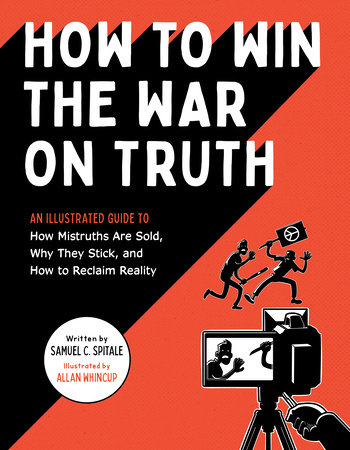
In an atmosphere where graphic novels are mischaracterized as “graphic,” “obscene,” or “pornography,” where teachers and librarians are verbally attacked and threatened, shedding light on the nuance and truth of the recent attacks on books is important. One of the biggest issues is the misdirection and the Orwellian use of language. If only there were a handbook to help cut through the rhetoric!
This latest entry in the “What I’m Reading” column focuses on a book that may help. How to Win the War on Truth: An Illustrated Guide to How Mistruths are Sold, Why they Stick, and How to Reclaim Reality was published in October 2022. Written by Samuel C. Spitale, it is illustrated heavily throughout with many sequential art elements by Allan Whincup. The book landed on my radar after visiting the Quirk Books table at this year’s New York Comic Con.
Description from the publisher:
Samuel C. Spitale examines how propaganda impacts our lives, shapes our world views, and damages our democracy — and argues that understanding this is the key to protecting ourselves and making informed decisions. This informative, humorous, and cleverly illustrated book uses elements of the graphic novel format to break down complex ideas through easy-to-understand real-world examples of propaganda in all its forms.
“Because we spend 11–12 hours a day interacting with media, it’s time to turn our media consumption into media literacy.”
Knowledge is Power
How to Win is packed with information. It includes key terms, case studies, and a history of marketing and propaganda. Spitale begins the book by laying the ground work of our post-truth nation. A nation where we “believe things that sound like truth, but aren’t.” He then moves on to discussing the marketing theories of Edward Bernays and how his concepts are used to sell products and as propaganda to sell ideas.
A recent report by PEN America, later echoed by The New York Times, made the important connection between recent book challenges and the funding and resources the challengers receive from public interest groups. In light of that context, several sections in How to Win stood out to me as having additional importance in relation to the defense of comics.
Perhaps most important is the concept and use of heuristics, the “mental shortcuts that help us simplify the decision-making process.” The discussion progresses to implicit bias, confirmation bias, and availability heuristics, which can lead to confirmation bias. It may seem like a lot of terms to be throwing around, but the book does a great job of breaking them down and presenting real-world examples.
What struck me about this section is how it relates to the challenges we see. It is evident from written challenges and from videos coming out of school and library board meetings many challengers are making emotional, snap judgments. It has to be in the hundreds how many times challengers and media outlets have mislabeled material as pornographic and, in the case of Maia Kobabe’s Gender Queer, claimed 20-somethings were children. Instead of engaging with the material, folks are seeing either what they want or what they’ve been primed to see.
How to Win later addresses how these concepts are used to create an us versus them mentality that can, and is often, manipulated by politicians. It was difficult for me not to draw another correlation between the us versus them mentality and the politicians who have used book bans to bolster their runs for political office.
A Picture Book
This book is a poster child for the power of the image to relay complex issues. For a book that covers psychology, marketing, politics, and neuroscience, it does a fabulous job teaching key terms and concepts. The various sections often include infographics that deftly handle the intellectual heavy lifting. What could have been a bogged-down text comes alive with illustrations.
The visual elements also prove incredibly helpful in showing contrast between what people say in their rhetoric and what is happening at the moment. An example of this is an identical panel showing the same person yelling “Commie!” to criticize various movements throughout history from the 1920s through the 1960s, attacking such movements as women’s suffrage, the civil rights movement, and even the fluoridation of drinking water.
Do not get the impression that the book is necessarily heavy. There is a sense of humor to the whole thing as it often gleefully points out the misconceptions and contradictions many of us carry around.
The best way to fight propaganda is to recognize it!
The Promise
I was expecting a section in the backend on “How to Reclaim Reality” from the powers that be. Really, the lesson of the book is we need to clean our own house and work on recognizing propaganda and bias in our own lives to stop the cycle.
I see this book as essential reading for today’s climate. With so many news sources disappearing and an influx of “entertainment news,” this book makes a bold step toward educating folks on how to navigate the current landscape in an informed way. And, as the author states, “The best way to fight propaganda is to recognize it!”
What I’m Reading is an opinion series written by editor Jordan Smith. The goal of the series is to highlight media related to the comics community that resonates with the mission of the Comic Book Legal Defense Fund.
